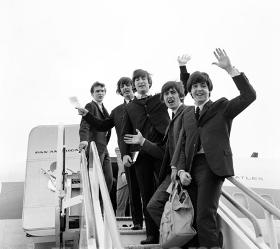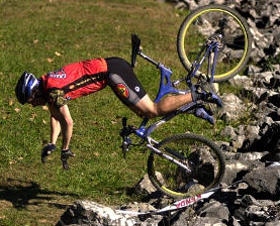Getting on a Plane

We all want to get on a plane

This is no way to get planing
Planing: it's why most of us windsurf. When the board pops on top of the water and accelerates, everything about our experience on the water changes. That's not to take away from the joy and experience of a non-planing session but most of us want (and need) the part of windsurfing that begins at about 15 mph on the water.
The transition from sub-planing to planing can also be a pretty significant hurdle for the intermediate windsurfer. Board and sail trim, feet placement and steering all change. Furthermore, you now have to deal with foot straps and harness lines. Worse, in variable conditions like we have here in Atlanta, getting on a plane often coincides with significant wind changes (gusts).
With all this going on, it can be daunting. Worse, often we end up in one of the more humbling ways to crash on a windsurfer, a catapult - over the handlebars
We've been asked by learning windsurfers how to get on a plane while remaining attached and standing on the board. While we do it ourselves, we find it more and more difficult to explain because there are a lot of things going on at once and a lot of it depends on how powered up we are, what kind of board, the water conditions, etc. The more we think about it, the more we realize that we should just shut up. But saying nothing isn't very helpful, either.
So, we've done some searching and would like to recommend at least three good resources we've found online:
Matt Pritchard How to get planing on your windsurfer
Matt not only writes about it but videos a teaching session with an intermediate who is working on getting on a plane better. He pays a lot of attention to MBP (Mast Base Pressure)
Shawna Cropas Windsurfing Technique
We just pointed out Shawna's web site the other day. She does a good job talking about body, hip and foot position and how doing it right keeps you on the board.
Peter Hart Early Planing
Peter has long done windsurfing tutorials. This post on the Starboard Forums does a good job talking about some of the finer points of early planing - planing when you are underpowered. The tips apply to whether you have a 4.5 or 9.5 rigged. And as summer approaches here, it's worth a read as this is the time of year when winds are the lightest.
Get Windsurfing
More video for reinforcing what all this looks like in your mind's eye.
You think you are the only one going through this. You aren't. We've all done it. For ourselves, we were lucky and there wasn't a GoPro handy.
Thanks for the videos...although a few more catapults and I may take up gymnastics
I've often said that one virtue of windsurfing is that we make our mistakes on water, rather than on pavement, dirt, ice or...
mats. Six minutes of reasons windsurfing is better than gymnastics:
https://www.youtube.com/watch?v=PqMWzf-SAdQ
--- The Arrogant Jerk: Crabby and irritable since 1998.
It occurred to me at some point that getting launched is a vital precursor to getting planning. In both cases you have the power to plane. In the case of getting launched the power is moving through your harness lines to your waist and you go forward really fast. However, your board doesn't really go anywhere very fast. To plane all you have to do is get the power to go through your waist down your legs to your feet into the board and it goes really fast with you on it. Now - how you do that is better explained by people who know how to actually teach the sport. I will say this - I've found it a lot easier to get planning by getting into the straps first, since it locks your feet in place and makes it harder to get launched. (Back in the heyday of rec.dot.windsurfing this was a subject of endless debate however so don't take this as gospel.)
(I guess my inner crash test dummy is saying its best to work on getting launched......Probably not the conventional approach. However, next time you get launched take heart - it means you are getting close.)
What happens in a black hole stays in a black hole.
Randy, I totally agree with you but I found it was a bit more difficult and complex than that to explain - hence, the post. I had even written a bit about getting into the front strap but felt that what those pages had to say was more important and deleted it.
What you and I do subconsciously, tends to not be what "newbies" (used as a term of endearment, not derision) do instinctively. Yeah, windsurfing is like that. In reading those articles, a few things stood out to me that I do but don't explain very well:
Shawna's tip about hip and foot position. Most newbies stand very sideways to the board and the front foot tends to face across rather than to the mast step. I think Tinho is pretty big on this point, too.
Pritchard talks about staying low and I think that's a pretty big deal, too. It feels odd to a newbie to hang low and off the booms - they tend to stand pretty upright. Staying low (arms straight, legs bent) can get one through a lot of wind.
Then little things like hand position - many/most experienced windsurfers turn the front hand under which opens the shoulders/hips (or is it that open shoulders hips make you turn the hand? whatever). In the video of the guy from Miami who eats it above, you can see how his shoulders on down are turned towards the sail rather than forward. I think (as just some guy on the internet) that his hand position contributes to this. As one begins to plane and the sail is still quite open, the front hand can be over but as the sail comes in, it's better to put it under. Compare Pritchard's front hand to his student's in the top picture from his page:
Again, in general, I totally agree with you. The front strap is, in my mind, the "control" strap between me and the board. In light winds and on wide boards, I will get in the front strap even before planing by hanging from the hook and placing the back foot right beside it so I don't sink the tail. If it's blowing hard, I get in the front strap and then the hook/backstrap and really hard, backstrap then hook. The scary thing I hear a lot of newbies say is that they are sailing in the back strap, not front while hooked in. In that case, it's only a matter of time before things go bad.
In the end, there are a lot of little things that go into staying on the board and off the nose. I hope that readers look and watch through the stuff and find the bits that they haven't thought about before. And, I certainly remember being on the water and having an "aha" moment where something I'd read a year before suddenly made sense.